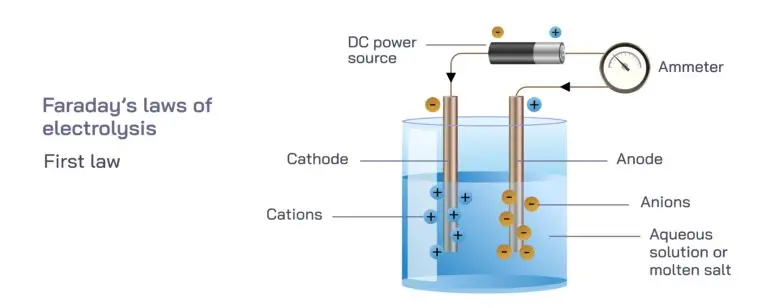Faraday’s Law

Table of Contents
What is Faraday's Law?
Faraday’s law of electromagnetic induction is a principle in physics that describes the relationship between a changing magnetic field and the induced electromotive force (emf) or voltage in a conductor.
The English scientist Michael Faraday discovered it in the 1830s, a cornerstone of electromagnetism. Faraday’s law has two main formulations: Faraday’s first law and Faraday’s second law.
Faraday’s First Law: This law states that a change in the magnetic environment of a coil or conductor will induce an electromotive force (emf) or voltage in the conductor. Essentially, whenever the magnetic field through a loop or coil changes, whether by altering the field strength, moving the coil through the field, or rotating it, an emf is induced in the conductor. This principle is the basis for generating electricity in power plants, where mechanical energy rotates coils within magnetic fields, inducing an EMF and, hence, electric current.
Faraday’s Second Law: The second law quantifies the induced emf, stating that the magnitude of the induced emf is directly proportional to the rate of change of the magnetic flux through the conductor. The induced emf is equal to the negative rate of change of the magnetic flux through the coil. The negative sign reflects Lenz’s law, indicating that the induced emf will produce a current whose magnetic field opposes the change in magnetic flux that produced it.
Concepts of Faraday's Law
Magnetic Flux
Magnetic flux, denoted as \varPhi, is a key concept in electromagnetism, representing the quantity of magnetism or the total magnetic field B passing through a specific area A. The concept is essential for understanding phenomena like electromagnetic induction.
Magnetic flux quantifies how much magnetic field passes through a given area. If the magnetic field is uniform and perpendicular to the area, the magnetic flux is simply the product of the field strength and the area size. However, if the field is not perpendicular to the area, only the magnetic field component perpendicular to the area contributes to the flux.
The standard unit for measuring magnetic flux is the weber (Wb). One weber represents the magnetic flux which, passing through a circuit of one turn, produces an electromotive force of one volt as it is reduced to zero at a uniform rate in one second. Another way to express magnetic flux is in tesla-square meters (T·m²), where 1 Wb equals 1 T·m².
Induced Emf
The concept of induced electromotive force (emf) is central to the principle of electromagnetic induction discovered by Faraday. Induced emf refers to the voltage generated in a conductor or coil when exposed to a changing magnetic field. This change can occur due to the conductor’s movement within a magnetic field, the variation of the magnetic field strength, or the alteration of the area enclosed by the conductor in the magnetic field.
When a conductor cuts through magnetic lines of force, an electromagnetic field is induced in it. This phenomenon is described by Faraday’s law, which states that the magnitude of the induced electromagnetic field is proportional to the rate of change of the magnetic flux through the conductor or coil.
The induced emf generates a potential difference in the conductor, and if the conductor is part of a closed circuit, this potential difference causes an electric current to flow. Lenz’s law gives the direction of the induced current, which states that it will flow in a direction that opposes the change in magnetic flux that produced it.
Lenz's Law
Lenz’s law, named after the physicist Heinrich Lenz, who formulated it in 1834, is a fundamental principle in electromagnetism that provides the direction of the induced electromotive force (emf) and current resulting from electromagnetic induction. It complements Faraday’s law of induction and is grounded in the energy conservation principle.
Lenz’s law states that the induced EMF and the resulting current in a closed conducting loop will be in a direction that opposes the change in magnetic flux through the loop. If the magnetic flux through a coil increases, the induced current will flow in a direction that produces a magnetic field opposing the increase. Conversely, if the magnetic flux decreases, the induced current will flow in a direction that tries to maintain the magnetic flux by opposing the decrease.
The basis of Lenz’s law is the conservation of energy. The opposition to the change in magnetic flux requires work against the induced electromagnetic forces when the magnetic field through a conductor changes. This opposition ensures that energy is conserved in the process of electromagnetic induction.
Applications of Faraday's Law
Generators: Faraday’s law is the principle behind the operation of electrical generators, where mechanical energy is converted into electrical energy by inducing EMF by rotating a coil in a magnetic field.
Transformers: Faraday’s law is also fundamental to transformers. These devices step up or down voltage levels in electrical circuits by inducing EMF in primary and secondary coils through magnetic coupling.
Induction Cooking: Induction cooktops use Faraday’s law to generate heat in ferromagnetic pots and pans by inducing eddy currents through alternating magnetic fields.
Electromagnetic Compatibility (EMC): Faraday’s law is essential in understanding and mitigating electromagnetic interference (EMI) and ensuring electromagnetic compatibility (EMC) in electronic devices and systems.
Related Links
Electrons
Mass
Matter
Biotechnology